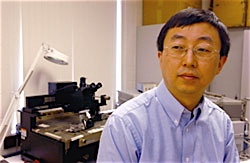New Chip Delivers Better Performance, Longer Battery Life
New chip delivers better performance, longer
battery life for wireless equipment: cell phones, wi-fi, wireless
hardware.

Professor Hui Wu
Anyone who uses a cell phone or a WiFi laptop knows the irritation of a dead-battery surprise. But now researchers at the University of Rochester have broken a barrier in wireless chip design that uses a tenth as much battery power as current designs and, better yet, will use much less in emerging wireless devices of the future.
Hui Wu, professor of electrical and computer engineering at the University of Rochester, a pioneer in a circuit design called an “injection locked frequency divider,” or ILFD, has solved the last hurdle to making the new method work. Wireless chip manufacturers have been aware of ILFD and its ability to ensure accurate data transfer using much less energy than traditional digital methods, but the technique had two fatal flaws: it could not handle a wide range of frequencies, and could not ensure a fine enough resolution within that range. Wu, together with Ali Hajimiri, associate professor of electrical engineering at California Institute of Technology, surmounted the first problem in 2001, and has now found a solution for the latter.
Wu’s new design makes the practical application of ILFDs possible. He introduced a new topology into this circuitry—instead of the old three-transistor design, his has five transistors—creating what he calls “differential mixing.” The new circuitry topology allows the ILFD to divide by three as well as two.
This tiny change has huge ramifications. A circuit design that can divide by two or three can, for instance, divide 9,999 clock pulses by two, and the 10,000th by 3, giving an average of 2.0001, which could be the frequency at which the cell phone is trying to communicate. Should the phone need to communicate at 2.0002 gigahertz, the ILFD could divide 9,998 clock pulses by two, and the 9,999th and 10,000th by three, yielding an average of 2.0002. By varying how many clock pulses are divided by two or by three, any frequency can be selected, making the power-saving ILFD method viable for the first time.
When I posted this, this morning, over at www.dvorak.org, I couldn't resist making a silly joke about folks having to turn off overheating cell phones. In truth, this is really welcome news. The possibilities of lighter wireless-portable devices that have reduced battery requirements is a real breakthrough. Kudos to Professor Hui.
Posted: Fri - April 21, 2006 at 11:35 AM